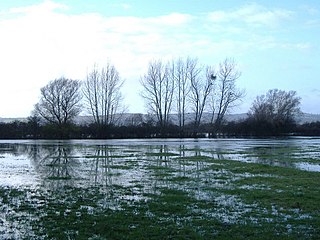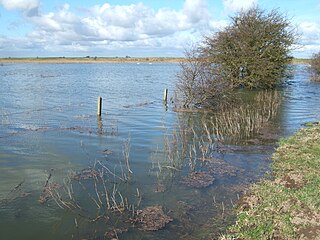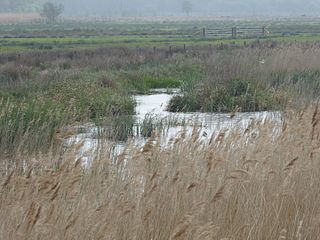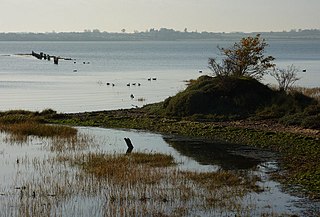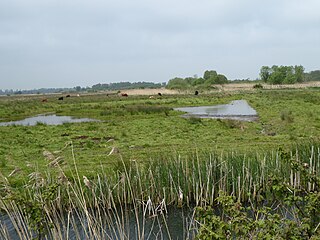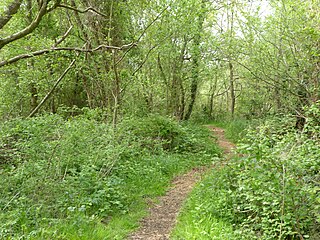| Eilean na Muice Duibhe | |
|---|---|
| Duich Moss | |
| Location | Islay, Scotland |
| Nearest city | Bowmore |
| Coordinates | 55°43′20″N6°15′20″W / 55.722222°N 6.255556°W Coordinates: 55°43′20″N6°15′20″W / 55.722222°N 6.255556°W |
| Area | 5.76 km2 (2.22 sq mi) [1] |
| Established | 1988 |
| Governing body | Scottish Natural Heritage (SNH) |
Eilean na Muice Duibhe, also known as Duich Moss, is an area of low-level blanket mire on the island of Islay, off the west coast of Scotland. Located south of the town of Bowmore and with an area of 576 hectares, the area has been protected as a Ramsar Site since 1988. [2]
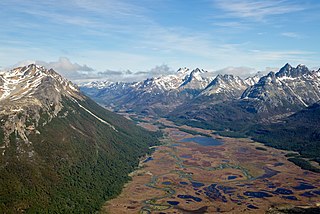
A mire is a wetland type, dominated by living, peat-forming plants. Mires arise because of incomplete decomposition of organic matter, due to waterlogging and subsequent anoxia. Like coral reefs, mires are unusual landforms in that they derive mostly from biological rather than physical processes, and can take on characteristic shapes and surface patterning.

Islay is the southernmost island of the Inner Hebrides of Scotland. Known as "The Queen of the Hebrides", it lies in Argyll just south west of Jura and around 40 kilometres (25 mi) north of the Northern Irish coast. The island's capital is Bowmore where the distinctive round Kilarrow Parish Church and a distillery are located. Port Ellen is the main port.

Scotland is a country that is part of the United Kingdom. Sharing a border with England to the southeast, Scotland is otherwise surrounded by the Atlantic Ocean to the north and west, by the North Sea to the northeast and by the Irish Sea to the south. In addition to the mainland, situated on the northern third of the island of Great Britain, Scotland has over 790 islands, including the Northern Isles and the Hebrides.
The site includes an unusual transition from blanket bog to raised mire habitats. It supports an internationally important population of white-fronted geese, with 2% of the Greenland population overwintering at the site. Breeding birds include the common redshank, red-throated loon and hen harrier. [3]

The common redshank or simply redshank is a Eurasian wader in the large family Scolopacidae. The genus name Tringa is the New Latin name given to the green sandpiper by Aldrovandus in 1599 based on Ancient Greek trungas, a thrush-sized, white-rumped, tail-bobbing wading bird mentioned by Aristotle. The specific totanus is from Tótano, the Italian name for this bird.

The red-throated loon or red-throated diver is a migratory aquatic bird found in the northern hemisphere. The most widely distributed member of the loon or diver family, it breeds primarily in Arctic regions, and winters in northern coastal waters. Ranging from 55 to 67 centimetres in length, the red-throated loon is the smallest and lightest of the world's loons. In winter, it is a nondescript bird, greyish above fading to white below. During the breeding season, it acquires the distinctive reddish throat patch which is the basis for its common name. Fish form the bulk of its diet, though amphibians, invertebrates, and plant material are sometimes eaten as well. A monogamous species, the red-throated loon forms long-term pair bonds. Both members of the pair help to build the nest, incubate the eggs, and feed the hatched young.

The hen harrier is a bird of prey. The genus name Circus is derived from Ancient Greek kirkos, meaning 'circle', referring to a bird of prey named for its circling flight. The specific cyaneus is Latin, meaning "dark-blue".
As well as being recognised as a wetland of international importance under the Ramsar Convention [2] , Greenlaw Moor has also been designated a Special Protection Area. [1]

The Ramsar Convention on Wetlands of International Importance especially as Waterfowl Habitat is an international treaty for the conservation and sustainable use of wetlands. It is also known as the Convention on Wetlands. It is named after the city of Ramsar in Iran, where the Convention was signed in 1971.
A Special Protection Area (SPA) is a designation under the European Union Directive on the Conservation of Wild Birds. Under the Directive, Member States of the European Union (EU) have a duty to safeguard the habitats of migratory birds and certain particularly threatened birds. Together with Special Areas of Conservation (SACs), the SPAs form a network of protected sites across the EU, called Natura 2000. Each SPA has an EU code – for example the North Norfolk Coast SPA has the code UK9009031.

